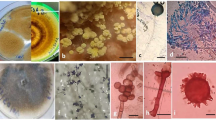Abstract
The changes in NADPH activity was studied in the roots of 3–4-day-old etiolated pea (cultivar Aksaiskii usatyi) seedlings depending on plant inoculation with Rhizobium leguminosarum bv. viceae (strain CIAM 1026), adverse environmental factors (low temperature and high dose of a mineral nitrogen fertilizer), chemical substances (sodium nitroprusside and methyl viologen, or paraquat), and a biotic factor—the bacterium Escherichia coli (strain XL-1Blue). It was demonstrated that all exogenous factors increased the activity of microsomal NADPH oxidase. Rhizobial infection removed the activation caused by exogenous factors only in the case of high nitrogen content in the medium, thereby displaying an antagonistic effect. A synergistic action on the enzyme activity was observed in the variants with combined action of rhizobia + paraquat and rhizobia + E. coli. An increased NADPH oxidase activity coincided with a growth inhibition of pea seedling roots. The results are discussed from the standpoint of the roles of NADPH oxidase and reactive oxygen species in the legume-rhizobium symbiosis.
Similar content being viewed by others
References
Tarchevskii, I.A., Signal’nye sistemy kletok rastenii (Signaling Systems in Plant Cells), Moscow: Nauka, 2002.
Sagi, M. and Fluhr, R., Plant Physiol., 2006, vol. 141, no. 2, pp. 336–340.
Men’shchikova, E.B. and Zenkov, N.K., Usp. Sovrem. Biol., 2006, vol. 126, no. 1, pp. 97–112.
Sagi, M., Davydov, O., Orazopva, S., Vesbergenova, Zh., Ophir, R., Stratmann, J.W., and Fluhr, R., Plant Cell, 2004, vol. 16, no. 3, pp. 616–628.
Jiang, M. and Zwang, J., Planta, 2002, vol. 215, no. 6, pp. 1022–1030.
Sagi, M. and Fluhr, R., Plant Physiol., 2001, vol. 126, no. 3, pp. 1281–1290.
Soto, M.J., Sanjuan, J., and Olivares, J., Microbiology, 2006, vol. 152, no. 11, pp. 3167–3174.
Lohar, D.P., Sharopova, N., Endre, G., Penuela, S., Samac, D., Town, C., Silverstein, K.A.T., and Vanden-Bosch, K.A., Plant Physiol., 2006, vol. 140, no. 1, pp. 221–234.
Shaw, S.L. and Long, S.R., Plant Physiol., 2003, vol. 132, no. 4, pp. 2196–2204.
Genetika simbioticheskoi azotfiksatsii s osnovami selektsii (Genetics of Symbiotic Nitrogen-Fixation System with Basics of Breeding), Tikhonovich, I.A. and Provorov, N.A., Eds., St. Petersburg: Nauka, 1998.
Lukatkin, A.S., Fiziol. Rast., 2002, vol. 49, no. 5, pp. 697–702.
Glyan’ko, A.K., Makarova, L.E., Vasil’eva, G.G., and Mironova, N.V., Izv. Ros. Akad. Nauk, Ser. Biol., 2005, vol. 32, no. 3, pp. 300–305.
Martinez-Abarca, F., Herrera-Cervera, J.A., Bueno, P., Sanjuan, J., Bisseling, T., and Olivares, J., Mol. Plant-Microbe Interact., 1998, vol. 11, no. 2, pp. 153–155.
Bueno, P., Soto, M.J., Rodriguez-Rosales, M.P., Sanjuan, J., and Donaire, J.P., New Phytol., 2001, vol. 152, no. 1, pp. 91–96.
Shen, W., Nada, K., and Tachibana, S., Plant Physiol., 2000, vol. 124, no. 1, pp. 431–439.
Pinton, R., Cakmak, I., and Marschner, H., J. Exp. Bot., 1994, vol. 45, no. 1, pp. 45–50.
Buzun, G.A., Dzhemukhadze, K.M., and Mileshko, L.F., Fiziol. Rast., 1982, vol. 29, no. 1, pp. 198–200.
Hahn, M.G., Annu. Rev. Phytopathol., 1996, vol. 34, pp. 387–412.
Asai, S., Ohta, K., and Yoshioka, H., Plant Cell, 2008, vol. 20, no. 5, pp. 1390–1406.
Ferguson, B.J. and Mathesius, U., J. Plant Growth Reg., 2003, vol. 22, no. 1, pp. 47–72.
Penfield, S., New Phytol., 2008, vol. 179, no. 3, pp. 615–628.
Gimalov, F.R., Chemeris, A.V., and Vakhitov, V.A., Usp. Sovrem. Biol., 2004, vol. 124, no. 2, pp. 185–196.
Vasil’eva, G.G., Mironova, N.V., Glyan’ko, A.K., and Shepot’ko, L.N., Fiziol. Biokh. Kul’t. Rast., 2001, vol. 33, no. 2, pp. 176–181.
Vasil’eva, G.G., Mironova, N.V., and Glyan’ko, A.K., Fiziol. Biokh. Kul’t. Rast., 2004, vol. 36, no. 6, pp. 534–542.
Besson-Bard, A., Pugin, A., and Wendehenne, D., Annu. Rev. Plant Biol., 2008, vol. 59, pp. 21–39.
Wong, H.L., Pinontoan, R., Hayashi, K., Tabata, R., Yaeno, T., Hasegawa, K., Kojima, C., Yoshioka, H., Iba, K., Kawasaki, T., and Shimanoto, K., Plant Cell, 2007, vol. 19, no. 12, pp. 4022–4034.
Lamb, C. and Dixon, R.A., Annu. Rev. Plant Physiol. Plant Mol. Biol., 1997, vol. 48, pp. 405–410.
Nagata, M., Murakami Ei-Ichi, Shimoda Y., Schimoda-Sasakura F., Kucho Ken-Ichi, Suzuki A., Abe M., Higashi S., Uchiumi T, Mol. Plant-Microbe Interact., 2008, vol. 21, no. 9, pp. 1175–1183.
Glyan’ko, A.K., Mitanova, N.B., and Vasil’eva, G.G., Prikl. Biokhim. Mikrobiol., 2008, vol. 44, no. 4, pp. 438–441.
Author information
Authors and Affiliations
Corresponding author
Additional information
Original Russian Text © A.K. Glyan’ko, G.G. Vasil’eva, A.A. Ischenko, N.V. Mironova, A.L. Alekseenko, 2010, published in Prikladnaya Biokhimiya i Mikrobiologiya, 2010, Vol. 46, No. 4, pp. 479–485.
Rights and permissions
About this article
Cite this article
Glyan’ko, A.K., Vasil’eva, G.G., Ischenko, A.A. et al. The NADPH oxidase activity of pea seedling roots in rhizobial infection depending on abiotic and biotic factors. Appl Biochem Microbiol 46, 438–443 (2010). https://doi.org/10.1134/S0003683810040137
Received:
Published:
Issue Date:
DOI: https://doi.org/10.1134/S0003683810040137




